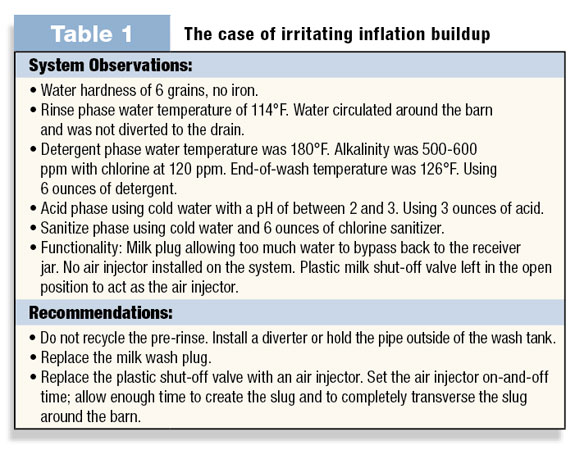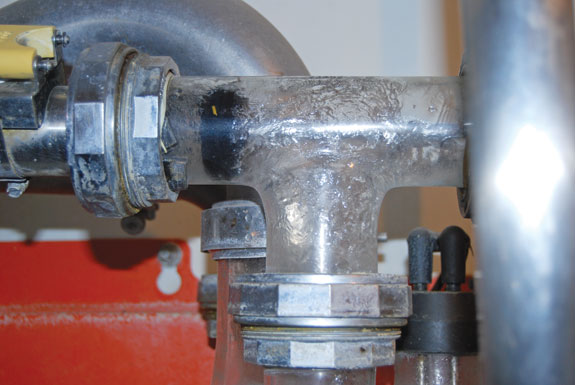Milking equipment cleanliness and proper functionality play a big role in achieving peak milk quality. Often when producers attempt to correct problems related to high standard plate count (SPC) or protein, fat and mineral buildup in their pipeline and inflations, they find a variety of issues to blame. Such was the case with a Progressive Dairyman reader who wrote to us in search of answers.
This dairy producer from Wisconsin was milking in a 40-cow stall barn with a two-inch round-the-barn pipeline system. He reported having problems with hard particle buildup inside the inflation cups. The buildup was occurring after just two weeks of inflation use. His cows finally gave him the kick he needed to get on the case – literally! Cows were agitated when the unit was applied because of the rough particles in the inflations.

We went to the farm to observe the system and found several factors influencing the milking system’s clean-in-place (CIP) efficiency and performance. ( See Table 1 .)
As we watched the system work, we noticed the milk plug was allowing too much water to bypass back to the receiver jar, preventing enough water to generate the slug needed to travel around the barn. An air injector was never installed on the system. Instead, a plastic milk shut-off valve was left in the open position to act as the air injector. This was also interfering with the slug transverse around the barn.
The usual suspects: Pre-rinse procedures
Next, we noticed the water temperature in the rinse phase was 114°F and the water was circulated around the barn rather than being diverted to the drain. We recommended installing a diverter, or holding the pipe outside the wash tank, thereby not recycling the pre-rinse water. Doing so allows the milk solids to go down the drain rather than being redeposited back into the system.
This producer’s problem is not unusual. We always recommend flushing to remove nearly all soils in the pre-rinse phase. In fact, we believe it is essential to keep flushing until the rinse water is clear. Whether milking in a stall barn with a pipeline or in a parlor, we find the majority of problems are traced back to inadequate pre-rinse procedures. Compounding the problem (and also compounding costs) is the erroneous practice of using a higher concentration of chemicals in an attempt to make up for inadequate pre-rinse procedures.
Equipment improvements
In addition to the pre-rinse improvements, we recommended replacing that faulty milk wash plug, and replacing the plastic shut-off valve with an air injector. We also recommended setting the air injector on-off time, which would allow enough time to create the slug and enough time to completely transverse the slug around the barn.
Finally, we inspected the farm’s water-heating system. While the two water heaters in place at the farm were providing an adequate supply of hot water, it appeared at first blush that the heaters were not set adequately to provide a constant supply throughout the cleaning process. Further inspection found that the lower heating element on the hot water heater had deteriorated.
While pursuing solutions related to the water-heating system, the dairyman in this case did try increasing the amount of detergent used as a way to get rid of milkstone. It worked at first, but a white residue eventually returned to the inflations and irritated the cows.
Remember, increasing the amount of soap is not always the answer. Water temperature and hardness greatly influence the detergent’s effectiveness. For many detergents, water at the end of the cycle must be a minimum of 120°F. On most farms that means starting temperatures must be approximately 160°F. The dairyman in our case was able to correct the faulty heating element on the water heater.
Be a CIP detective
The particles in the Wisconsin producer’s inflations were the result of all these issues contributing to improper cleaning of the pipeline. So, case closed. That is, the case is closed until next milking, when the milkers’ eyes and ears will be once again on the lookout for more clues that signal a developing issue.
Because there are so many factors involved in keeping the CIP system working properly, and because changing one thing affects another aspect of the system, producers should be visually vigilant and inspect their systems regularly.
Schedule a thorough chemical survey every six months with your chemical provider. Remember that many parts make up the whole in milk quality. PD

-
Ron Robinson
- Vice President
- Business Development A&L Laboratories
- Email Ron Robinson

See the black milk wash plug in this photo? The plug has been “grooved” too much, allowing excessive water to bypass back to the receiver jar, resulting in an inadequate or poor slug and ineffective pipeline cleaning. Photo courtesy of Ron Robinson.
Want to know how well your CIP system is doing? Submit a photo of your CIP challenges or a question to Progressive Dairyman . In future issues, A&L Laboratories experts will comment on the photos or questions. Dairy names and locations will not be connected with photos, so your review will be completely anonymous. Send your photos and questions to walt@progressivedairy.com





